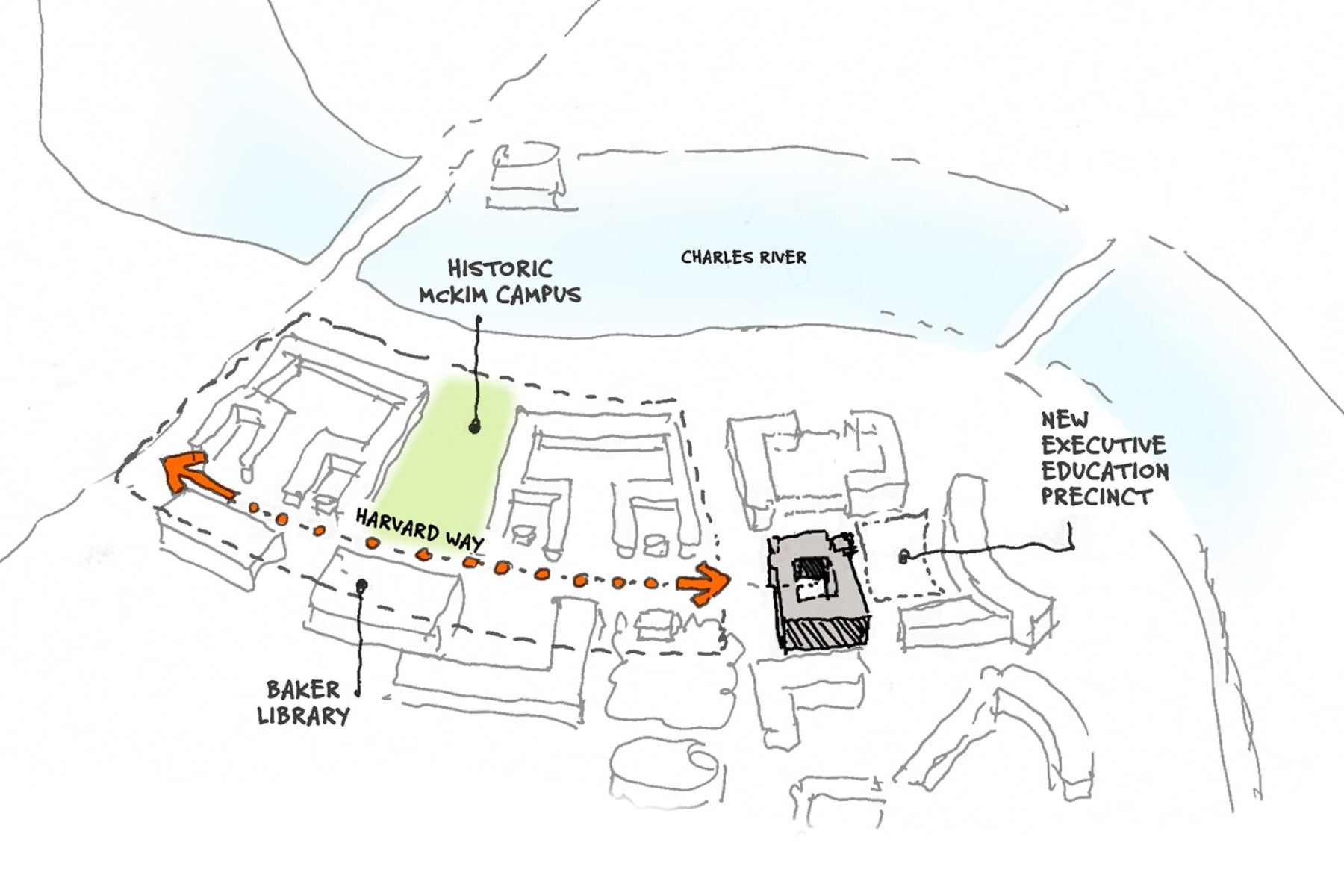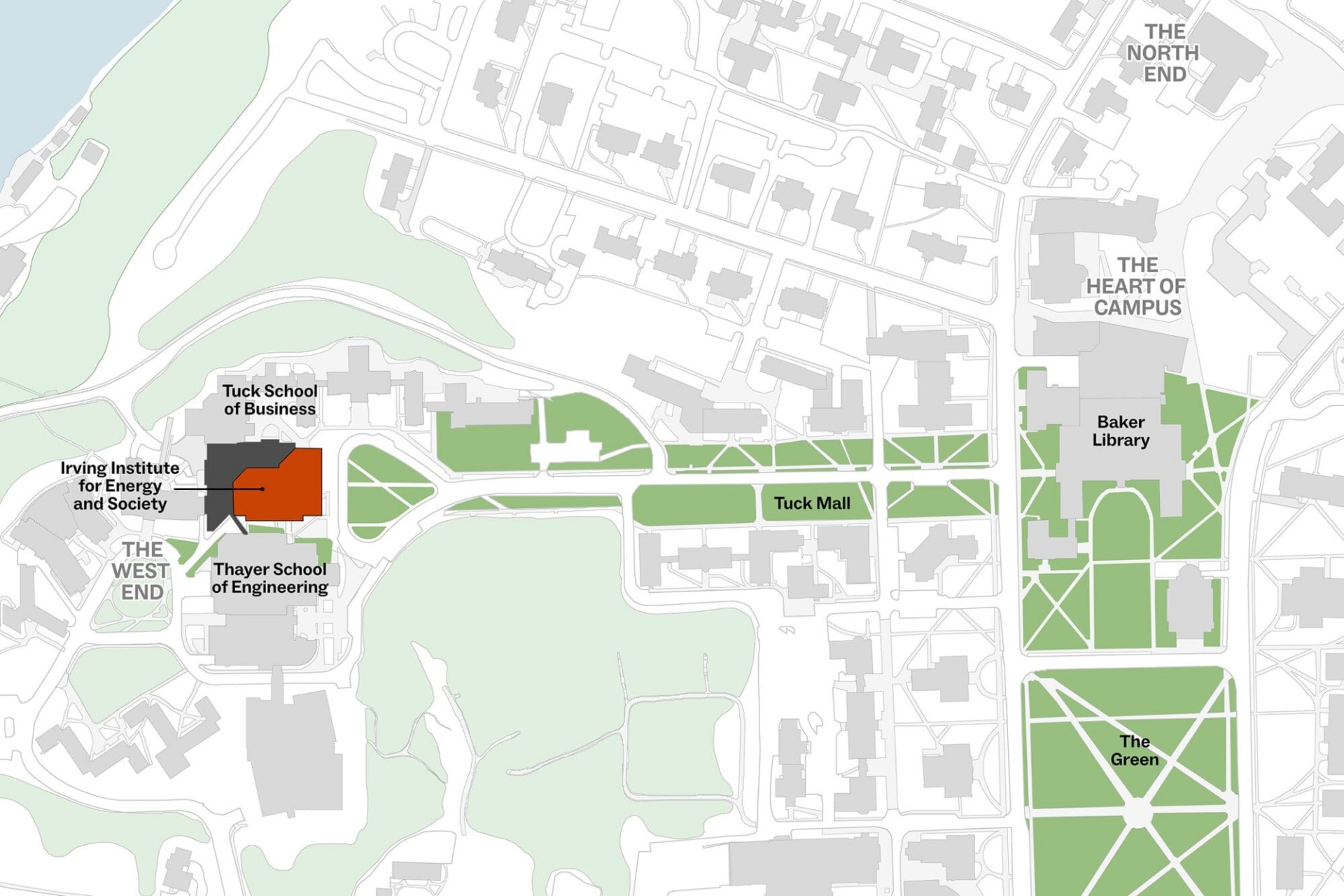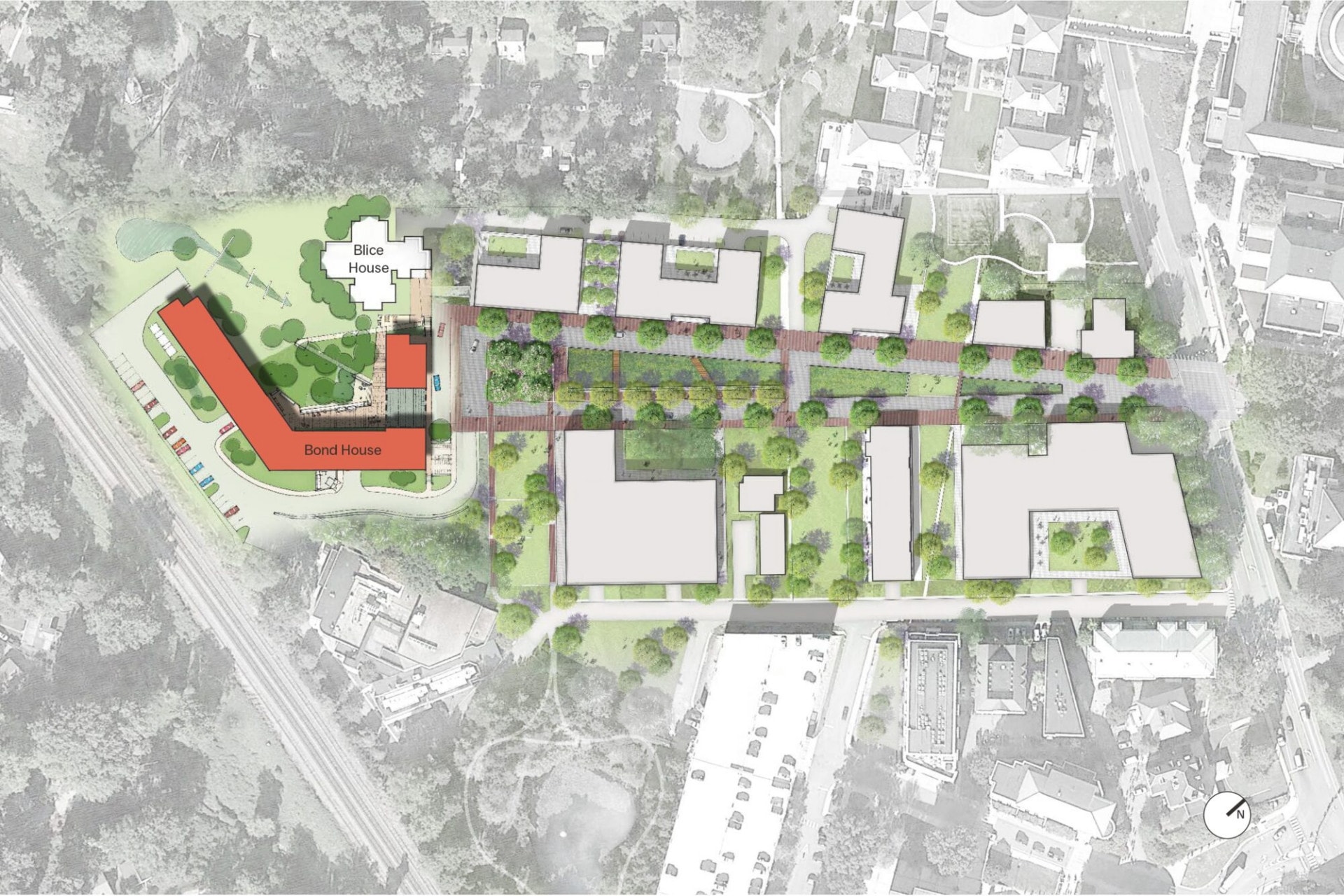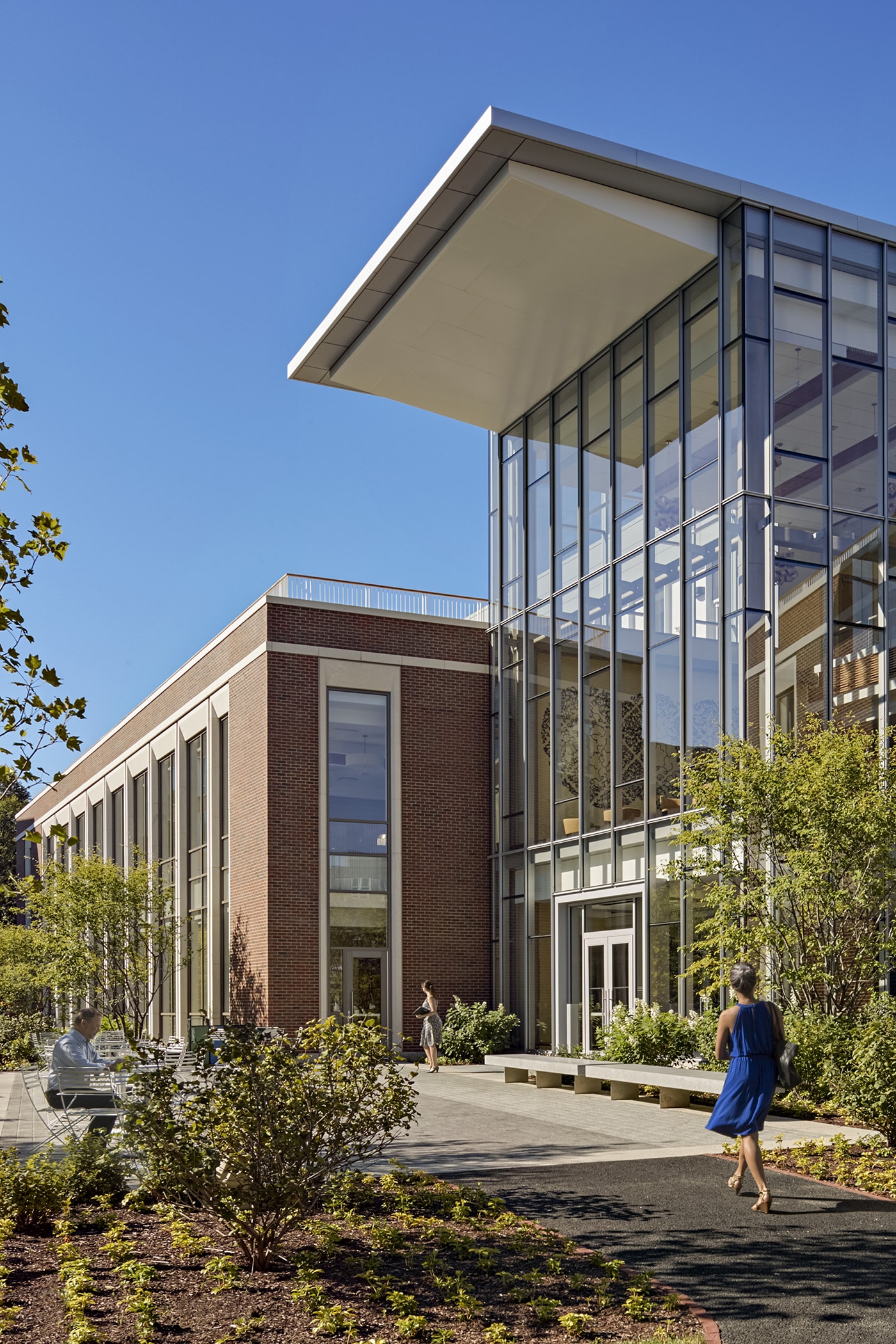Thomas Jefferson’s “Academical Village” at UVA set a new national standard for campus planning in the early 19th century. Rooted in classical architecture, his vision prioritized symmetry and a strong axial view from a central rotunda down a tiered lawn to distant mountains. An inspiring view down a green axis—often with an iconic building at its terminus—is an experience that defines many college campuses to this day. These buildings and axes are powerful conveyors of meaning, and they form strong impressions on the memories of visitors and alumni.
Designing a building at the end of a campus axis requires purpose and intentionality. A building on axis should have the strength of concept to “hold” the axis—it must stand out and be worthy, in some way, of its potent location. However, as a single piece within a thoughtfully composed campus, it often must also be a piece that “fits.” We have had the honor of designing on campus axes many times. Here are a few examples of how we have answered this challenge on very different campuses and with very different programs.

Axis 1: Harvard Way (Harvard Business School)
Harvard Business School is organized around a primary axis, which extends from Baker Library down a green lawn flanked by residential buildings towards the Charles River. Its secondary axis, Harvard Way, is the pedestrian spine of the school’s McKim, Mead & White-designed legacy campus—both a social “Main Street” and the physical manifestation of its brand. The new Chao Center is sited at the terminus of this axis, directly between the historic campus and a new executive education precinct to the east.
This axial gateway site required a trick of duality: it had to be deferential to the legacy architecture, yet prominent enough to “hold” its axial position and give a visitor clarity from afar that traveling down the axis would be rewarded by a Destination.

Our design solution uses material, proportion, and classical form to achieve this delicate balance. Brick and limestone facades, and the proportions and placement of facade elements (cornice, window, base), reflect defining features of the McKim, Mead & White campus. The building’s entrance rotunda also “fits”—but it is this element that gives the Chao Center the prominence required of a building at the end of a campus axis. The rotunda is a classical element traditionally reserved only for the most important buildings; we read it as a symbol of specialness. Thus the Chao rotunda achieves the design’s impossible goal: demurring yet special, background yet focal.


Axis 2: Tuck Mall (Dartmouth College)
Baker Library is the most iconic building on the Dartmouth Campus. In front of it to the South lies the Dartmouth Green, the school’s famed quadrangle. To its west runs the Tuck Mall—a broad lawn lined with mature trees and crisscrossed by pedestrian paths, with a paved street running through its center. The new Irving Institute for Energy and Society is located at the western end of Tuck Mall.

Tuck Mall has become a more important campus axis since the May 2022 opening of Dartmouth’s West End Innovation District, a new destination for students and faculty engaging in interdisciplinary problem-solving and research. In light of the West End’s centrality to Dartmouth’s future vision, it was important that the Irving Institute make a strong statement, one that would more closely tie the West End to the historic campus center. Moreover, the Institute needed to “make far near,” providing a visual focal point that would encourage pedestrians to walk the length of Tuck Mall to the West End.
Like the Chao Center at Harvard Business School, the Irving Institute needed to mediate between the duality of providing a strong terminus to its axis and “fitting in” with its neighbors. And like at Chao, the solution at Irving was found in scale and material. The design limits the building’s height, keeping it comparable to adjacent buildings. Its overall mass is mediated by the design of a narrow front wing with a gabled roof—a familiar scale and form within the district—which then connects in the back to two additional wings. Traditional brick, copper/metal roofs, and white trim also respectfully match the style of surrounding campus architecture.


The Irving building’s entrance pavilion rises to meet the challenge of appropriately terminating the Tuck Mall axis. Sitting proud of the building’s brick façade, not only does it provide a strong vertical element that glows as a beacon at night, it also demonstrates the institute’s energy mission: the pavilion is a thermal vent, a central element in the building’s impressive natural ventilation system. Visitors to the West End can see the pavilion’s windows and shades automatically opening and closing in response to climatic conditions. At night, the pavilion’s lights can be set to glow different colors based on the building’s energy performance that day. The Irving building’s pavilion is therefore a compelling visual and symbolic counterpoint to Baker Library’s tower; a symbol of academic research facing a demonstration of research-in-action.


Axis 3: Brandon Avenue Green Street (University of Virginia)
Brandon Avenue is located south of the Jeffersonian Academical Village on the UVA grounds. It has recently been redeveloped as a student-focused “Green Street”; a working bioretention landscape runs the center of its length, mixing plants and hardscape to treat area stormwater. Sited at the terminus of the avenue, the new Bond House residence hall anchors the green street.
Bond House had fewer conditions constraining its response to its axis than the Irving Institute or Chao Center. Existing buildings on Brandon Avenue were clad in traditional UVA brick and cast stone trim, and new construction was required to follow suit, with height limitations clearly defined, but Brandon Avenue was not part of the historic campus core, and the Bond House site was not located opposite another building. The axis it needed to respond to, therefore, consisted entirely of the unique, functional green space leading to its site.

Our first desire was to not terminate the axis, but to extend it—to extend the green street right into and through our building and continue the sense of community created by this shared outdoor space. The first floor at Bond House would be home to the UVA Democracy Initiative, a research and training program with participants drawn from across campus; we wanted participants to be welcomed in to enjoy the building’s site. Similarly, a residence hall adjacent to our site had no dedicated outdoors space of its own; we wanted residents of that building to enjoy greater parity of amenities by sharing our site.
We were inspired by passage in and through green spaces elsewhere on UVA grounds. There are memorable portals that one passes through—moving from the Lawn, through a narrow passage between buildings, then into an intimate landscape bounded by brick walls. This felt like a uniquely UVA experience—this green expanse, then compression, then a narrowed, contained landscape—and we sought to create something with a similar soul on our site.


The two-story portal entrance to Bond House achieves our design goals for the Green Street axis. It extends the green street rather than terminating it, it invites residents and other members of the community to enter, and it provides a unique experience of nature along the green street—more sheltered, but still for everyone and anyone.


Although designing on axis involves some similar goals, the unique history, architectural vocabulary, and aspirations of each institution ensure that designing on campus and on axis will always require new solutions. It is one of the most interesting challenges I get to tackle as a designer of campus buildings, and it is an honor to collaborate with clients and colleagues to find the right expression for their campus, axis, and mission.








